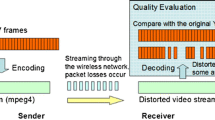Abstract
As the market for broadband video services matures, the ability to deliver high-value video content will become increasingly important. For the telecommunications industry to compete effectively with other video providers, it is vital that the quality of video services matches the expectations of customers. A major challenge lies in ensuring that the trade-off between price and quality is acceptable to consumers of broadband video. This paper introduces a new method for measuring in real-time the perceptual quality of video. The potential operational benefits of this method are discussed. The paper describes how a no reference video quality measurement method may be deployed as a mechanism for quality control at the point of video encoding and transmission. Further, it is proposed that a real-time video quality metric can be used to measure the quality received on end users’ devices. By applying perceptual quality measurements for quality control and feedback, this mechanism can be used to ensure adequate quality is delivered to customers, make more efficient use of bandwidth and thereby reduce backhaul costs, and act as a quality assurance check on the customer’s end device.
Similar content being viewed by others
References
Willis P J: ‘An introduction to quality of service’, BT Technol J, 23, No2, pp 13–27 (April 2005).
Engstrom E: ‘A study of television image characteristics’, Proceedings of the Institute of Radio Engineers, 21, pp 1631–1651 (1933).
Allnatt J W: ‘Transmitted-picture Assessment’, Wiley, London (1983).
Winkler S, Dufaux F: ‘Video quality evaluation for mobile streaming applications’, Visual Communications and Image Processing 2003, SPIE-Int Soc Opt Eng Proceedings of SPIE — The International Society for Optical Engineering, 5150, No1, pp 593–603 (2003).
Corriveau P, Gojmerac C, Hughes B and Stelmach L: ‘All subjective scales are not created equal: the effects of context on different scales’, Signal Processing, 77, No1, pp 1–9 (August 1999).
Hands D: ‘Temporal characterisation of the forgiveness effect’, Electronics Letters, 37, pp 752–754 (2001).
Voelcker R, Hands D, Davis A, Bourret A and Bayart D: ‘Video quality measurement — predicting subjective quality using perceptual models’, The Journal of the Communications Network, 2, Part 1, pp 40–45 (March 2003).
Video Quality Experts Group — http://www.vqeg.org/
ITU-T Recommendation J.144: ‘Objective perceptual video quality measurement techniques for digital cable television in the presence of a full reference’, Geneva (May 2003).
Ghanbari M: ‘Video coding: an introduction to standard codecs’, The Institution of Electrical Engineers, London (1999).
Bourret A J and Ghanbari M: ‘Video quality metric’, Patent Number: WO04054274 (2002).
Psytechnics — http://www.psytechnics.com/
Srinivasan S, Hsu P, Holcolb J, Mukerjee K, Regunathan S L, Lin B, Liang J, Lee M-C and Ribas-Corbera J: ‘Windows Media Video 9: overview and applications’, Signal Processing: Image Communication, 19, No9, pp 851–875 (October 2004).
ITU-T Recommendation H.264: ‘Advanced video coding for generic audiovisual services’, Geneva (May 2003).
European Union Fifth Framework Project Number IST-1999-11429: ‘Market Managed Multiservice Internet’, — http://www.m3i.org/
Bouch A and Sasse M A: ‘The case for predictable network service’, in Nahrstedt K and Feng W (Eds): ’Proc MMCN’2000’, San Jose, CA, pp 188–195 (January 2000).
Aldridge R, Davidoff J, Ghanbari M, Hands D and Pearson D: ‘Measurement of scene-dependent quality variations in digitally coded television pictures’, IEE Proceedings on Vision, Signal and Image Processing, 142, pp 149–154 (1995).
About this article
Cite this article
Hands, D., Bourret, A. & Bayart, D. Video QoS enhancement using perceptual quality metrics. BT Technol J 23, 208–216 (2005). https://doi.org/10.1007/s10550-005-0017-2
Issue Date:
DOI: https://doi.org/10.1007/s10550-005-0017-2




